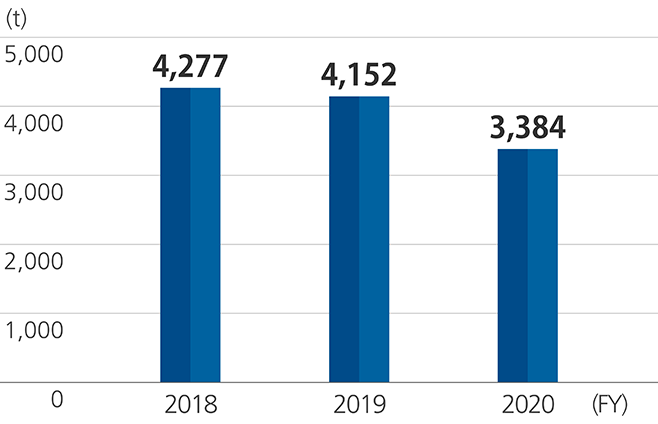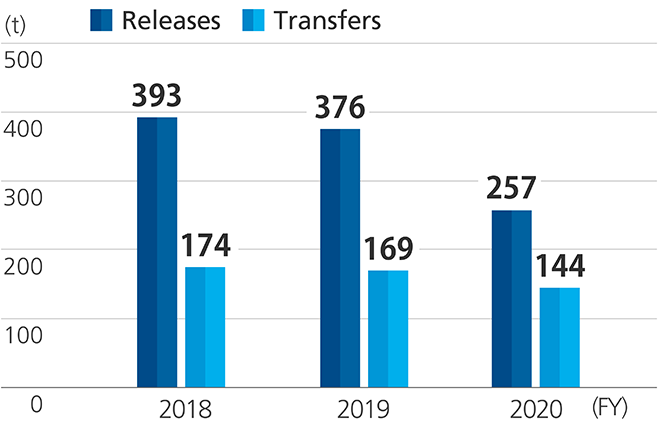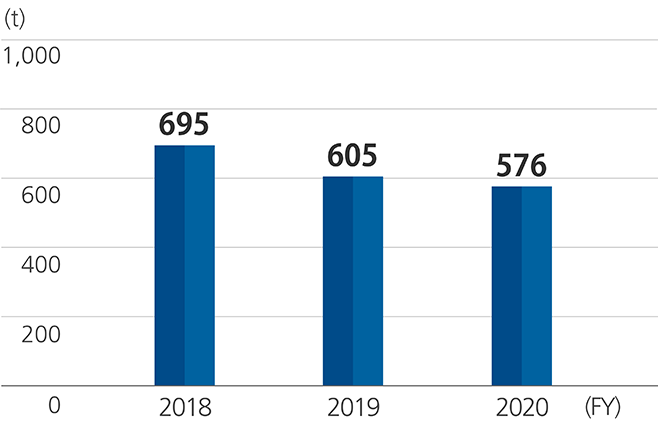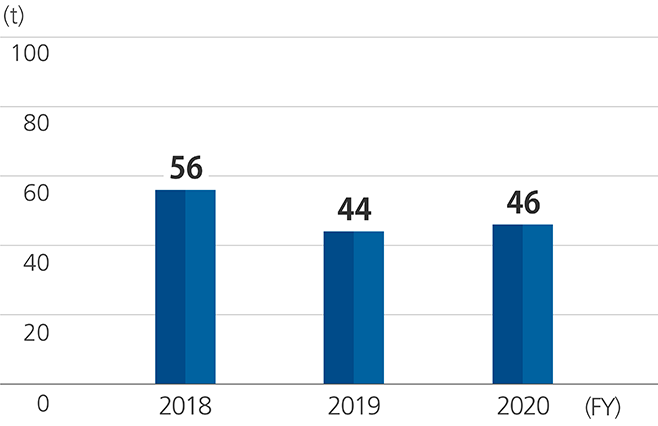Chemical Substance Management and Pollution Prevention
Basic Approach
The UACJ Group strives to properly manage chemical substances and control emissions while also switching to chemicals with low impacts on the environment and human health. We do this out of concern not only for effects on the natural environment but also for safety - for employees engaged in manufacturing our products and customers when they use our products. In our efforts to control emissions, we have established and abide by our own standards, which are stricter than those set forth in Japan’s Air Pollution Control Law, Water Pollution Control Law, local government ordinances, and conventions.
Fiscal 2023 Results
Pollutant Control at Individual UACJ Works (Fiscal 2023)
○: Measurements fall within standards
| Measurement Item | Fukui Works |
Fukaya Works |
Nikko Works |
|
|---|---|---|---|---|
| Air | NOx, SOx, soot and dust | ○ | ○ | ○ |
| Water | pH, BOD | ○ | ○ | ○ |
| n-H (mineral oil), SS | ○ | ○ | ○ |
Control of PRTR Substances
The UACJ Group seeks to reduce pollutants by utilizing the Pollutant Release and Transfer Register (PRTR) system*1 based on the Act on the Assessment Releases of Specified Chemical Substances in the Environment and the Promotion of Management Improvement* to ascertain and disclose the amounts of substances handled, released, and transferred in its operations.
In fiscal 2023, the volume of chemicals handled decreased by 157 tons (4.7%) from fiscal 2022 due reduced production; however, the Group’s total emissions and transfer volume of target substances increased by 25 tons (12.2%) and 1 ton (0.7%), respectively. The primary reason for the increase in emissions and transfers was the legislative change in reportable substances under the PRTR law in 2022.
*1 The PRTR system requires businesses handling chemical substances that are potentially hazardous to human health and the environment to estimate the amounts of chemical substances released from business sites into the environment (air, water, and soil) and transferred in waste, and report the data to the local governments. The governments then compile the reported data and estimates and publish the emission and transfer volumes.
Amounts of PRTR Substances Handled
(Contain manganese, chromium, nickel, and lead as alloy substances)

Amounts of PRTR Substances Released or Transferred

- Note 1 Measurement scope: UACJ (Nagoya, Fukui, Fukaya, Nikko), UACJ Aluminum Center Corporation, Utsunomiya Color Aluminum, UACJ Extrusion Nagoya Corporation (Nagoya, Anjo), UACJ Extrusion Oyama Corporation, UACJ Extrusion Gunma Corporation, UACJ Extrusion Shiga Corporation, UACJ Foil Corporation (Isesaki, Shiga, Nogi), UACJ Foundry & Forging Corporation.
- Note 2 Companies and sites as of September 30, 2024.
Handling, Releases, and Transfers of PRTR Substances (Fiscal 2023)
| No. | Substance | Amount Used (kg) | Amount Released (kg) | Amount Transferred (kg) |
|---|---|---|---|---|
| 412 | Manganese and its inorganic compounds | 1,596,084 | 0 | 14,040 |
| 300 | Toluene | 550,989 | 32,157 | 46,550 |
| 80 | Xylene | 191,828 | 18,308 | 1,944 |
| 594 | Ethylene glycol monobutyl ether *2 | 166,245 | 5,889 | 1,274 |
| 273 | 1-dodecano | 157,991 | 90,733 | 36,078 |
| 87 | Chromium and chromium(III) compounds | 141,746 | 15 | 28,158 |
| 691 | Trimethylbenzene*2 | 117,677 | 67,566 | 1,615 |
| 53 | Ethylbenzene | 87,177 | 3,040 | 722 |
| 627 | Diethylene glycol monobutyl ether*2 | 60,738 | 1,933 | 409 |
| 737 | Methyl isobutyl ketone*2 | 19,627 | 570 | 120 |
| 88 | Hexavalent chromium and its compounds | 16,150 | 0 | 3 |
| 374 | Hydrogen fluoride and its water-soluble salts | 14,489 | 1,320 | 11,877 |
| 308 | Nickel | 14,326 | 0 | 0 |
| 302 | Naphthalin | 10,073 | 323 | 67 |
| 207 | 2,6-Di-tert-butyl-4-cresol | 4,652 | 1,650 | 2,950 |
| 407 | Poly (oxyethylene) = alkyl ether | 3,352 | 3,259 | 60 |
| 321 | Vanadium compounds | 2,815 | 0 | 0 |
| 392 | n-hexane | 2,612 | 387 | 848 |
| 697 | Lead and its compounds | 2,525 | 0 | 0 |
| 83 | Cumene | 1,458 | 496 | 6 |
| 411 | Formaldehyde | 1,101 | 9 | 3 |
| 595 | Ethylenediaminetetraacetic acid and its potassium and sodium salts | 1,085 | 1,066 | 8 |
| 333 | Hydrazine | 1,073 | 782 | 96 |
| 3,165,812 | 229,502 | 146,827 |
- Note 1 Measurement scope: UACJ (Nagoya, Fukui, Fukaya, Nikko), UACJ Aluminum Center Corporation, Utsunomiya Color Aluminum, UACJ Extrusion Nagoya Corporation (Nagoya, Anjo), UACJ Extrusion Oyama Corporation, UACJ Extrusion Gunma Corporation, UACJ Extrusion Shiga Corporation, UACJ Foundry & Forging Corporation, UACJ Foil Corporation (Shiga, Nogi, Isesaki).
- Note 2 Companies and sites as of September 30, 2024.
- *2 Substances subject to the PRTR Law revisions
Reducing VOC Releases
The UACJ Group has designated toluene, xylene, ethylbenzene, and trimethylbenzene as substances to be reduced and is taking steps to reduce atmospheric emissions of volatile organic compounds (VOCs).
The Group’s exhaust gas treatment systems, including the deodorizing equipment at Utsunomiya Color Aluminum Works installed in the previous year, sustained the low level of atmospheric emissions in fiscal 2023. Progress was also made toward incorporating an alternative substance for paint thinner.
Prevention of Air Pollution
The UACJ Group is seeking to reduce emissions of air pollutants by maintaining and managing plant facilities and by converting fuel sources from heavy oil to LNG. Efforts to date are enabling the Group to maintain low levels of SOx and NOx emissions.
NOx Emissions

SOx Emissions

- Note1 Me asurement Scope: UACJ (Nagoya, Fukui, Fukaya, Nikko), UACJ Extrusion Oyama Corporation
- Note2 Companies and sites as of September 30, 2024.
Control of PCBs
The UACJ Group monitors the volume of PCB in equipment at its business sites, reports to the regulatory authorities, and properly stores and manages PCB in accordance with the Act on Special Measures Concerning the Promotion of Proper Treatment of Polychlorinated Biphenyl (PCB) Waste. Small electrical equipment, such as fluorescent light ballasts and electrical equipment, that may contain trace amounts or low concentrations of PCBs are also monitored, and equipment with levels exceeding the standard amounts are properly managed.
Detoxification of equipment containing PCB is contracted to Japan Environmental Storage & Safety Corporation for appropriate treatment. Detoxification oil with trace or low concentration of PCB contamination is contracted, as necessary, to certified treatment companies. We disposed of 50 capacitors and 143 ballasts as high-concentration PCB waste in fiscal 2023, meeting the March 2024 deadline for disposal. We also disposed of 34 transformers, 32 capacitors, and 2 ballasts as low-concentration PCB waste. The deadline for disposing equipment with low-concentration PCB waste is March 2027, and we are systematically examining, analyzing removing, storing, and disposing equipment containing low-concentration PCBs that is currently in use or storage at our worksites.
Addressing the Problem of Asbestos
The UACJ Group records the history of asbestos use, examines the current status, and implements measures to reduce asbestos in its products, factory buildings, equipment, and fixtures. The Group has never used asbestos in its product or sold products that contain asbestos.
In fiscal 2004, we began removing sprayed asbestos, which is has a high risk of becoming airborne, from the few places it was used in our buildings. Sprayed asbestos still remains at the Nogi Works of UACJ Foil Corporation, but we have verified that there is no dispersal. The revised the Air Pollution Control Act was enforced in June 2020 tightened regulations on asbestos in roofing slates and other sources with low asbestos risk, and we are taking the appropriate steps to comply with the law. In fiscal 2022, removal work was carried out at the Nogi Works of UACJ Foil Corporation.
We have replaced all equipment and fixtures that had high asbestos risk. When regularly scheduled inspections are conducted, we are replacing equipment and fixtures with low asbestos risk with equipment and fixtures that do not contain asbestos.
Measures to Control Dioxins
The UACJ Group’s aluminum melting furnaces are categorized as “specified dioxin-emitting facilities” under the Act on Special Measures against Dioxins, and we strive to maintain the concentration of dioxins in exhaust gas below the regulatory levels.
We do this by maintaining the optimum amount of combustion air in the aluminum melting furnace and thoroughly controlling the input materials, thereby preventing the production of dioxins.
As required by law, we also inspect our aluminum melting furnaces for dioxins each year and report the results to the government. The dioxin inspections in fiscal 2023 found levels below the legal requirements at all of our 24 designated air quality facilities and 2 designated water quality facilities.
Prevention of Water Pollution
The partially amended Water Pollution Prevention Act enforced in June 2012 requires the submission of notifications regarding hazardous substance in storage facilities, piping, and other areas as well as compliance with standards for structures and other facilities.
The UACJ Group completed the necessary actions at all operating sites prior to the end of the grace period on May 31, 2015.
Prevention of Soil and Groundwater Contamination
UACJ Extrusion Oyama Corporation and UACJ Color Aluminum Corporation used specified hazardous substances in the past and are continuing with cleaning operations for contaminated groundwater. The companies’ monitoring of the effectiveness of their efforts are showing that the contamination levels are decreasing.
Measures Deal with Soil and Groundwater Contamination
| Business Location | Period | Contaminant | Response |
|---|---|---|---|
| UACJ Extrusion Oyama Corporation | Since fiscal 1999 | Tetrachloroethylene | Soil replacement, water extraction and purification |
| UACJ Color Aluminum Corporation | Since fiscal 2004 | hexavalent chromium, fluorine | Soil replacement, water extraction and purification |
Note1 Companies and sites as of September 30, 2024.

